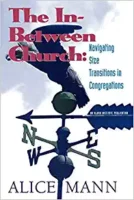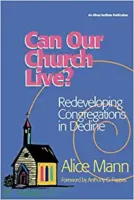[This article is part 3 of the series Crunch Time for Small Congregations.]
Another related approach might be called clustering. Several congregations decide to combine as a single mission unit, but maintain more than one location.
- One end of this spectrum would be full amalgamation—the Roman Catholic parish in my community is a single entity, but conducts services at more than one location. And there is an emerging trend toward multi-site Protestant ministries—not driven by scarcity or decline but by a vision for larger mission impact.
- In the middle of this spectrum is the model commonly called a “cluster,” “area parish,” or “regional ministry”—where one staff team serves multiple congregations, each with its own name and its own governing board. This model usually includes some shared programming, and an additional council that oversees the cluster relationship.
- And on the other end of the spectrum, we find a looser association of independent units, sharing certain negotiated expenses and programs. Two synagogues may merge their Hebrew Schools in order to build a single strong educational program. Or several churches may sponsor a single youth program.
General Characteristics of Clusters
General characteristics of the “cluster” or “area parish” model include
- A single staff team, comprised of two or more ordained clergy, and often other shared staff, that serves all the participating congregations: While there is some variation in the degree to which specific pastors may be assigned to particular congregations, clusters foster the notion that the whole (multi-location) parish is served by the whole pastoral team.
- Sharing of resources and programming: Unlike a “yoked” ministry (where clergy time is the main or only shared component), the cluster encourages congregations to undertake certain aspects of their life and program cooperatively, in order to strengthen the ministry of all. Common examples of co-operative programming would be youth activities, outreach projects, training for Sunday School teachers, and joint services on special occasions.
- Maintaining the identity of individual congregations: This approach is different from merger (or pre-merger co-operative efforts) in that there is usually an explicit intention to retain and strengthen the multiple locations as a positive resource for regional ministry.
- Development of lay leadership in each local setting: Lay leadership usually receives strong emphasis in this approach, both as a theological value in itself and as a practical necessity for congregations that do not have a resident, full-time, ordained pastor.
While these characteristics may help us to differentiate the cluster from other ministry strategies, the lived experience is much more complicated—reflecting both local variation in explicit structure and the inevitable gap between ideal and reality that would be found in any “model” of ministry.
Benefits of the Cluster Model
Clusters (by whatever name) have some particular benefits when compared to other options such as yoking, appointment of lay or locally ordained pastors to solo ministries, merger, or closing. Typical advantages of the cluster approach include
- Ministry in and to multiple “places”: In rural communities or in urban neighborhoods, the closing (outright or by merger) of a congregation may contribute to the decline of the community itself and cut off further opportunity for ministry with certain populations. The cluster model allows ministry to be rooted in multiple locations, while still benefiting from team leadership and co-operative programming.
- Stability and quality of the pastoral team: Sharing resources from multiple congregations can allow the creation of more stable full-time and part-time clergy positions than most of the individual congregations could manage on their own. Often, smaller congregations in rural and urban areas have experienced high clergy turnover due to low salaries, perpetual budget difficulties, challenging living conditions for clergy families, a tendency in some denominations to assign first-call clergy to these ministries, and the burden on part-time clergy to find complementary employment. When a cluster can offer stable positions at reasonable salary standards, the pool of applicants increases and the congregations have more choices. For some pastoral candidates (though probably not the majority), the team-ministry structure itself will be a big plus.
- Incentive to increase self-reliance and strengthen member ministry: While a growing spirit of self-reliance does not happen automatically, the cluster structure can encourage lay leadership development by:
- Defining new and important member roles;
- Establishing a network of peers for lay leaders;
- Creating an opportunity for shared training that would be much harder to provide individually, and
- Establishing administrative strength—in the form of capable management by the team leader, shared office staff and equipment, and help with standard tasks like newsletters, statistical reporting, and audits—that can make volunteer roles more manageable and satisfying for the average member.
- “Critical mass” in several shared programs: Small congregations often have trouble gathering enough youngsters for a good outing, or pulling together a large enough choir and congregation to have a glorious feast-day service. While there are limits to the number of activities congregations are willing to do jointly (while still maintaining their sense of local identity), the establishment of a few shared ventures can generate new hope, energy and effectiveness for these smaller congregations.
- Peer support for local leaders: Just as clergy may find ministry in the small church rather isolating, the same is true for church officers, Sunday School teachers, outreach committees, and youth leaders. Although it may initially be tough to persuade people to drive to another church location for a training event, the availability of peer support can, over time, make church leadership roles more appealing to a wider range of members, and gradually diminish “lone ranger” attitudes that sometimes flourish in small congregations.
Stress Points in the Cluster Model
We can also observe some common points of stress that emerge in the cluster approach.
- Disorientation without “our pastor”: In congregations used to having a settled, full- or part-time pastor of their own, church life tends to be organized around the person and position of pastor—in both conscious and unconscious ways. The smallest congregations may never have been organized this way, or may not have had a stable clergy presence for a long time before they joined a cluster. But for congregations that have recently relied on “our pastor” to take initiative, solve problems, meet needs, and hold things together, the absence of that familiar figure may leave them anxious, confused, and persistently dissatisfied with the cluster arrangement. Some congregations adapt and mature within this new structure; others get by. But a certain number of congregations never accomplish a sufficient shift in orientation and expectations to remain connected to a cluster for very long.
- Feelings of loss and grief: Movement into a cluster arrangement may be precipitated by congregational trauma (severe church conflict, clergy death, clergy misconduct, financial crisis) and/or by significant changes in the community. In rural areas, community shifts may include increased pressure on family farmers, depopulation, and the closing of local schools, businesses, hospitals and human services. Feelings of profound and pervasive loss may run deep in congregations as they enter into cluster arrangements; the accompanying grief may be expressed indirectly in the form of church fights, anger toward denominational officials or pastors, neediness, passivity, or simply a lack of energy for the demands and joys of new relationships. (See Managing Transitions by William Bridges.)
- Difficulties of negotiation: Life in a cluster is an eternal process of negotiation. Constituencies inside each congregation must be brought on board and kept in the loop; relationships between congregations must be monitored and maintained; the cluster staff and cluster council must constantly adjust to emerging circumstances; and all must maintain a working relationship with denominational officials. Negotiation is hard work, and small congregations—accustomed to operating on unspoken and informal arrangements—may find such work especially tedious and annoying.
- Accepting trade-offs: One mark of spiritual maturity, for individuals and congregations alike, is to accept the things we cannot change about our own circumstances, then get on with doing what we can to make life meaningful and satisfying. Every ministry arrangement includes some downside, some trade-offs, but congregations easily forget the downside of their struggles to maintain a “pastor of their own.” It is easy for participating congregations to dwell on things they have lost (whether or not the cluster was really the cause of that loss) rather than to settle into their current stage of life with a positive spirit and some degree of contentment.
- Perceiving the gains: From the point of view of any one person in the pew, it may be difficult to see (and feel) the full import of what has been gained by the whole cluster—and perhaps by the local communities they serve. Those who participate in the cluster council are probably most aware of the big picture and the specific accomplishments attained. Some of these deeply involved individuals may feel as though the cluster council is their real “congregation,” and may lose touch to some degree with the local ministry they represent. At the other end of the spectrum of connection, we find fringe members of a local church who may experience the cluster as an outside force that makes church life more complicated and confusing than they remember it ever being before. They are not sufficiently engaged in local church life to really “hear” the communications about cluster successes, or to participate in the enriched programming the cluster offers.
- Wondering “What if?” Sometimes a cluster contains a congregation that could—or could almost—sustain a solo full-time pastor on their own. Whereas a smaller congregation may be clear that it wouldn’t survive without the cluster structure, a relatively-larger church will probably ask itself from time to time whether they might grow better—in size or vitality—if they struck out on their own. Since the relatively larger congregation in a cluster may serve an important “anchoring” function for the whole enterprise, there is a potential for both guilt and resentment on the part of the larger church as it ponders the possibility of operating on its own.
First Hand Experience of Cluster Leaders
In 2008, I had the opportunity to engage in a research project with leaders from a number of Lutheran (ELCA) clusters (called “area parishes”) in the upper Midwest. Here are some findings from that research about the way the cluster is actually experienced by leaders. We asked lay leaders to comment on what was working well, where they were struggling, and what “burning questions” they had about their shared ministries
In response to the question “What’s working well?” lay leaders identified the following aspects of the cluster experience:
- Joint Services: While each cluster had its own pattern for conducting joint worship and festival services, these shared opportunities were valued as a tangible expression to the life of the larger entity. Specific examples of shared services included offerings of Wednesday or Saturday evening worship on a regular basis; Advent and Lenten musical programs or services; quarterly worship opportunities that rotate among the locations; and joint services at special times of the year.
- Offering a More Appealing Call to Pastors: Lay leaders felt that these ministry positions were more attractive to candidates because of the potential for teamwork, collegiality, schedule flexibility, room to “work to one’s strengths,” and opportunities for creative projects that a single small church might not offer. Lay leaders felt positively that they were able to meet denominational salary guidelines and provide an appealing ministry context for clergy couples.
- Shared Cluster Programming: Successful joint ventures lifted up by lay leaders included Vacation Bible School; training for Sunday School teachers; seasonal worship planning; Bible study opportunities; Confirmation classes; and youth activities.
- More Volunteers for Projects: The cluster relationships generated larger teams of volunteers to undertake community outreach efforts and fundraisers.
- Being Connected in the Cluster Council: Generally, two representatives from each congregation serve on this council. Lay leaders said they gained an expanded sense of community, and exposure to a wider range of viewpoints. One cluster council was pleased with their practice of reporting back—not just to each local church council, but to the congregations themselves.
- Cluster Newsletter: The cluster newsletter is an important vehicle for building communication and shared identity. In some cases, each congregation adds its own page of news to the cluster newsletter— emphasizing both the connection and the particularity of each local church.
Lay leaders also described areas of struggle that were specific to the cluster experience.
- Different Levels of Commitment: Some congregations don’t seem to be as committed to the cluster model as others. Those who joined the cluster at some time after its founding may feel they had not entered “in on the ground floor.” Other causes of low commitment were general unwillingness to change; transition to a “second generation” of lay leadership not involved in the founding of the cluster; fear of losing local identity; suspicion that someone is trying to close them down; not being able to point to “our pastor” any more; loss of control; jealousy; and fear of not being heard.
- Community Experiences with “Consolidation”: In some local communities, school consolidations have occurred in which early promises to maintain certain facilities or services were not fulfilled. This leaves people with a general skepticism about such arrangements.
- Competing Interests: Lay leaders described a tendency for each congregation to want the “special things” to happen in their space—such as Holy Week services or Reformation Sunday.
- Getting Congregations Together to Do Things: While the potential for cooperation may be great, organizing specific shared ventures is a challenging task.
- Reporting and Accountability: Congregations that maintained accountability in the past by receiving regular reports from their sole pastor (regarding visits, weddings, miles driven for pastoral work, etc.) may feel they can no longer assess the pastor’s work when it is part of a team ministry. “How do we know what the pastor is doing?”
Lay leaders offered several “burning questions” they were eager to talk about:
- How do we pay for future ministry? How do we create sustainable patterns of ministry? What constitutes a “fair share” from each congregation?
- How do we grow and invite others? With so much energy focused on the connections among the participating churches, these congregations may find it difficult to look outward toward incorporating people in the community who have no current church involvement.
- How do we minister in an age of new technology? Leaders experience bewilderment about the abundance of new communication media. They are asking whether and how they should involve themselves with new technologies. The cluster structure may actually speed such adaptation, both because it demands new forms of inter-congregational communication (such as email, list-serves, websites) and because it offers administrative resources (shared office staff and equipment) to implement these technology solutions.
The pastors serving on cluster staffs also provided information about their particular experience of ministry within this cluster approach. They described three aspects of the approach that are especially rewarding:
- Team Effort: This approach creates a community of colleagues with whom to plan and reflect; a diverse team whose collective gifts can meet a wider range of needs; an opportunity to offer a ministry specialty to the whole cluster; and a setting where clergy can learn from each other.
- Member Ministry: The pastors enjoy seeing church members share and use their gifts; the “team” aspect is not limited to the pastoral staff, but can extend to the sharing of ministry more broadly within the congregations.
- Gift Awareness: Pastors observed that the cluster approach encourages both the clergy and the churches to become more aware of their particular character, gifts, and unique contributions to the larger ministry.
When asked to identify specific stories that might illustrate the greatest potential of the cluster approach, pastors shared these examples:
- Food and shelter ministries that the congregations could never have undertaken on their own
- Sending a significant cluster delegation to a National Youth Gathering
- Robust schedule of special musical events
- Holy Week services
- Developmental work with church councils
- Prayer for one another
- Hope for the future—younger adults in our society place more value on cooperation and group effort than their baby-boom parents.
The pastors also had a great deal to say about the aspects of this ministry that they found most difficult or challenging. These included
- Complexity: Complexity grows exponentially as more individuals or components are added to a system; hence, a two-church arrangement would have four times the complexity of a stand-alone congregation. There is “a lot to track and follow up on.”
- Distinct Local Dynamics: Pastors are constantly crossing back and forth across cultural boundaries as they minister among the churches.
- Working with Fear, Loss, and Grief: As we have already noted, a deep sense of loss may pervade both the congregations and their surrounding communities. Pastors must be prepared for such feelings to surface at almost any time—sometimes expressed directly, but perhaps more often expressed indirectly. Maintaining an awareness of those grief reactions—and responding to them appropriately—is a key pastoral challenge in these settings.
- Establishing New Expectations: Signing a formal cluster covenant is not the end of the process. It may take years for church leaders and members to adjust their expectations to the new arrangement, and these expectations will need periodic adjustment as the cluster agreement evolves.
- Distance: Especially in the rural examples of the cluster model, clergy become acutely aware of the distances because they spend so much time on the road.
- Communication: One may encounter communication challenges inside even the smallest church; such challenges become compounded dramatically in the cluster arrangement.
One area of difficulty demands a section of its own—finding appropriate leadership style(s) in relation to Area Parish and congregational size. Pastors posed the question: “How do we lead in this environment with a mix of size dynamics?” The cluster itself may be a program-sized unit (often defined as an average Sunday attendance of 150-350 including children and Sunday School teachers).
Even if the combined attendance does not reach that level, the cluster is, by definition, a multi-cell system—that is, each member’s primary connection is with a particular constituent congregation, and the members would not expect to have a close relationship—or even to recognize—every member connected to the cluster. For more about multi-cell systems, see One Size Doesn’t Fit All by Gary McIntosh.
As a result of both the larger aggregate size and the multi-cell character of the system, the cluster functions in certain ways like a (stand-alone) program-size congregation.
- The key role of the pastor (particularly the pastoral team leader) is “administrator”
- Equipping lay leaders (as opposed to delivering ministry themselves) is a key clergy role
- Delegation is a crucial skill
- Intentional communication practices are essential.
Pastors operating in this “program” mode may function fairly comfortably with “family size” congregations in the cluster, particularly those small churches that have developed a cooperative and healthily self-reliant culture. (Such a culture is described very well in Kennon Callahan’s book Small, Strong Congregations.) Sometimes, however, the long-term survival struggles of the small church have produced an angry, rigid, or defensive church culture—focused more on guarding turf than on group spirit and cooperation.
Cluster staff may have a considerably greater challenge relating to congregations with a more pastor-centered orientation. Such churches place more value on having their “own pastor” to rely upon. They are more dependent on clergy to initiate, organize, solve problems and meet needs, and they are more demanding of clergy presence at church gatherings—major and minor, business and social. Such a congregation may make a partial adaptation to its circumstances by signing a cluster covenant, but may continue for some time to expect—deep down—that the pastor will always “be there.” For discussion of church size issues, see chapter one of Raising the Roof by Alice Mann.
[Return to the series Crunch Time for Small Congregations.]
Alice Mann is a leading consultant, educator, and author in the field of congregational development, whose work has focused on strategic planning, breaking through size plateaus, creating new pathways for small and struggling churches, and helping congregations to discern and care for the “soul” of their local community. Mostly retired from consulting and teaching, Alice is an active member of a small, engaged urban congregation and also offers leadership for faith-based community organizing in her region. She occasionally accepts one-time conversations with former clients and other church leaders on issues close to her heart.
Books by Alice Mann





